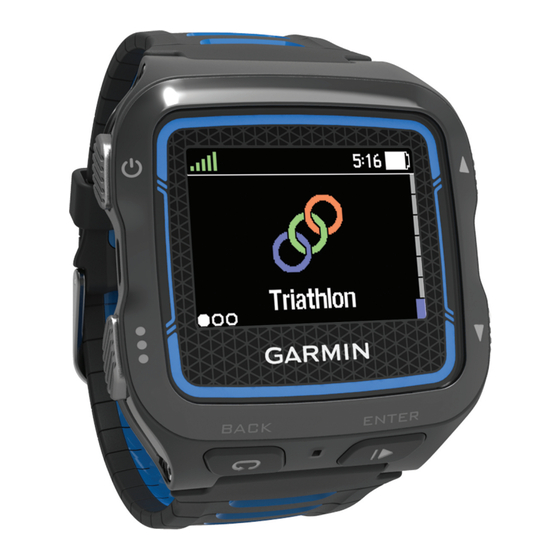- ページ 22
見る Garmin Forerunner 920XTのPDF オーナーズマニュアルをオンラインで閲覧またはダウンロードできます。Garmin Forerunner 920XT 28 ページ。
Garmin Forerunner 920XT にも: オーナーズマニュアル (24 ページ)

Restoring All Default Settings
NOTE: This deletes all user-entered information and activity
history.
You can reset all settings back to the factory default values.
Select
> Settings > System > Restore Defaults > Yes.
Viewing Device Information
You can view the unit ID, software version, GPS version, and
software information.
Select
> Settings > System > About.
Updating the Software
Before you can update your device software, you must have a
Garmin Connect account, and you must download the Garmin
Express application.
1
Connect the device to your computer using the USB cable.
When new software is available, Garmin Express sends it to
your device.
2
Follow the on-screen instructions.
3
Do not disconnect your device from the computer during the
update process.
NOTE: If you have already used Garmin Express to set up
your device with Wi‑Fi connectivity, Garmin Connect can
automatically download available software updates to your
device when it connects using Wi‑Fi.
Maximizing Battery Life
• Shorten the backlight timeout
• Shorten the timeout to watch mode
Settings, page
15).
• Turn off activity tracking
• Select the Smart recording interval
page
16).
• Turn off GLONASS
(Changing the Satellite Setting, page
• Turn off the Bluetooth wireless feature
Technology, page
6).
• Turn off the Wi‑Fi wireless feature
Technology, page
7).
Locking and Unlocking the Device Keys
You can lock the device keys to avoid accidental key presses
during an activity.
1
Hold
to view the shortcut menu.
2
Select Lock Device.
3
Hold
to unlock the device keys.
My daily step count does not appear
The daily step count is reset every night at midnight.
If dashes appear instead of your step count, allow the device
to acquire satellite signals and set the time automatically.
Tips for Erratic Heart Rate Data
If the heart rate data is erratic or does not appear, you can try
these tips.
• Reapply water to the electrodes and contact patches (if
applicable).
• Tighten the strap on your chest.
• Warm up for 5 to 10 minutes.
• Follow the care instructions
Accessory, page
10).
• Wear a cotton shirt or thoroughly wet both sides of the strap.
18
(Backlight Settings, page
(Power Save Timeout
(Activity Tracking, page
3).
(Data Recording Settings,
(Turning Off Bluetooth
‑ Fi
(Turning Off Wi
(Caring for the HRM-Run
Synthetic fabrics that rub or flap against the heart rate
monitor can create static electricity that interferes with heart
rate signals.
• Move away from sources that can interfere with your heart
rate monitor.
Sources of interference may include strong electromagnetic
fields, some 2.4 GHz wireless sensors, high-voltage power
lines, electric motors, ovens, microwave ovens, 2.4 GHz
cordless phones, and wireless LAN access points.
Data Fields
Some data fields require ANT+ accessories to display data.
%FTP: The current power output as a percentage of functional
threshold power.
%HRR: The percentage of heart rate reserve (maximum heart
rate minus resting heart rate).
10s Avg. Balance: The 10-second moving average of the left/
right power balance.
10s Avg. Power: The 10-second moving average of power
output.
30s Avg. Balance: The 30-second moving average of the left/
right power balance.
30s Avg. Power: The 30-second moving average of power
output.
30s Avg. Vertical Speed: The 30-second moving average of
vertical speed.
16).
3s Avg. Balance: The three-second moving average of the left/
right power balance.
3s Avg. Power: The three-second moving average of power
output.
Average %HRR: The average percentage of heart rate reserve
(maximum heart rate minus resting heart rate) for the current
16).
activity.
Average Balance: The average left/right power balance for the
current activity.
Average Cadence: Cycling. The average cadence for the
current activity.
Average Cadence: Running. The average cadence for the
current activity.
Average HR: The average heart rate for the current activity.
Average HR %Max.: The average percentage of maximum
heart rate for the current activity.
Average Lap Time: The average lap time for the current
activity.
Average Pace: The average pace for the current activity.
Average Power: The average power output for the current
activity.
Average Speed: The average speed for the current activity.
Average Stroke Distance: The average distance traveled per
stroke during the current activity.
Average Stroke Rate: The average number of strokes per
minute (spm) during the current activity.
Average Strokes/Length: The average number of strokes per
length during the current activity.
Average SWOLF: The average swolf score for the current
activity. Your swolf score is the sum of the time for one length
plus the number of strokes for that length
Terminology, page
used to calculate your swolf score.
Avg. Ground Contact Time: The average amount of ground
contact time for the current activity.
Appendix
(Swim
2). In open water swimming, 25 meters is
Appendix
